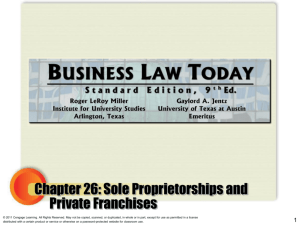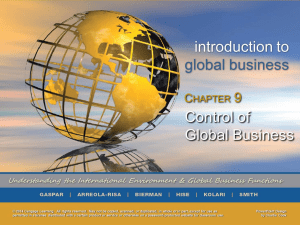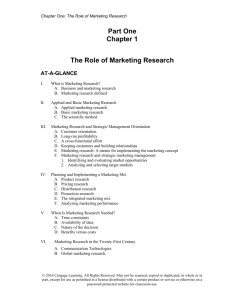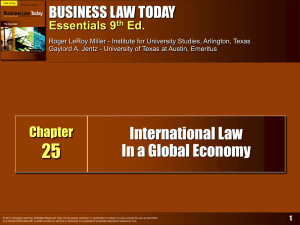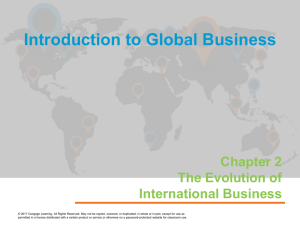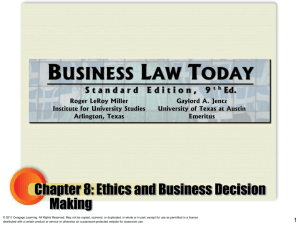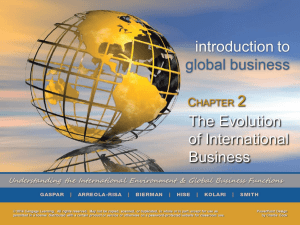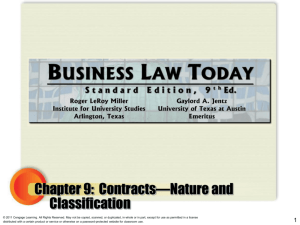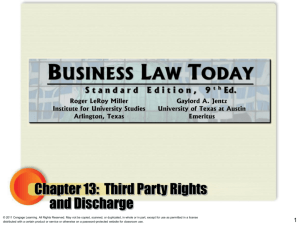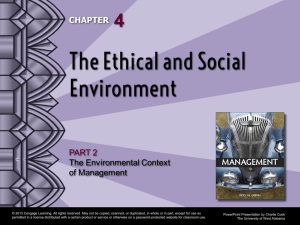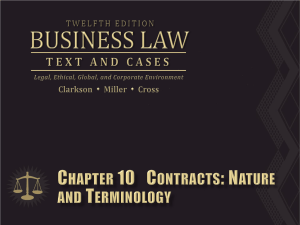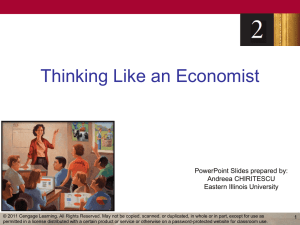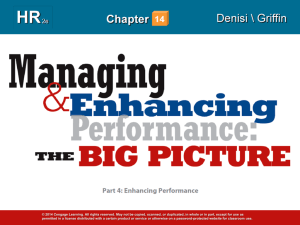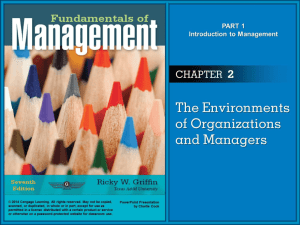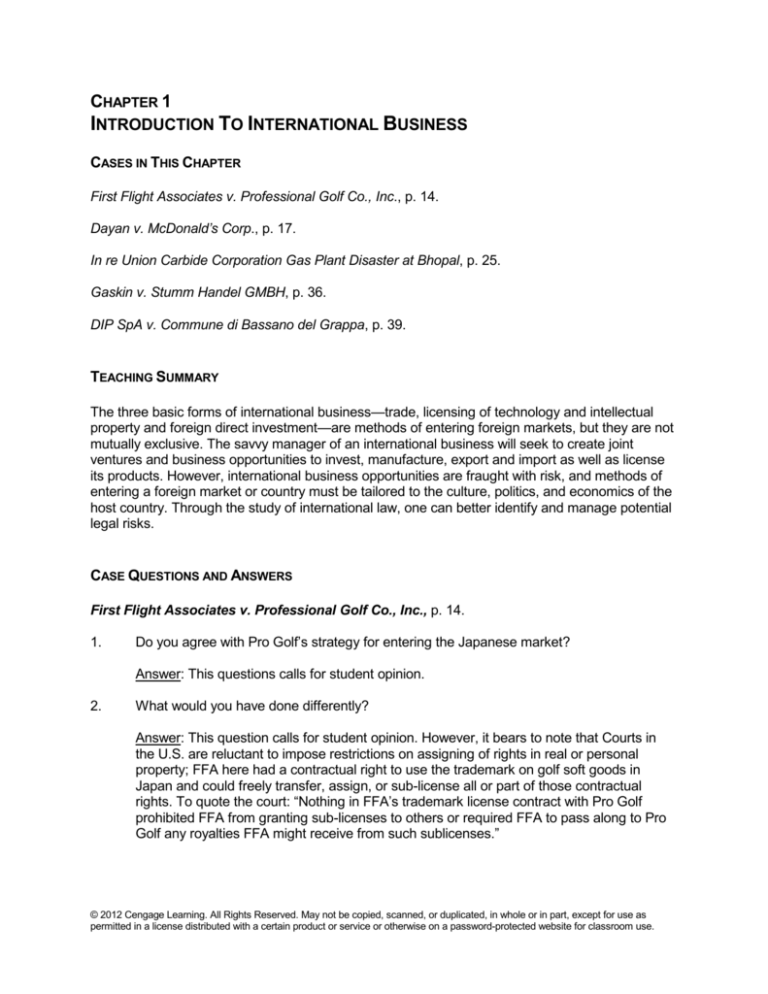
CHAPTER 1
INTRODUCTION TO INTERNATIONAL BUSINESS
CASES IN THIS CHAPTER
First Flight Associates v. Professional Golf Co., Inc., p. 14.
Dayan v. McDonald’s Corp., p. 17.
In re Union Carbide Corporation Gas Plant Disaster at Bhopal, p. 25.
Gaskin v. Stumm Handel GMBH, p. 36.
DIP SpA v. Commune di Bassano del Grappa, p. 39.
TEACHING SUMMARY
The three basic forms of international business—trade, licensing of technology and intellectual
property and foreign direct investment—are methods of entering foreign markets, but they are not
mutually exclusive. The savvy manager of an international business will seek to create joint
ventures and business opportunities to invest, manufacture, export and import as well as license
its products. However, international business opportunities are fraught with risk, and methods of
entering a foreign market or country must be tailored to the culture, politics, and economics of the
host country. Through the study of international law, one can better identify and manage potential
legal risks.
CASE QUESTIONS AND ANSWERS
First Flight Associates v. Professional Golf Co., Inc., p. 14.
1.
Do you agree with Pro Golf’s strategy for entering the Japanese market?
Answer: This questions calls for student opinion.
2.
What would you have done differently?
Answer: This question calls for student opinion. However, it bears to note that Courts in
the U.S. are reluctant to impose restrictions on assigning of rights in real or personal
property; FFA here had a contractual right to use the trademark on golf soft goods in
Japan and could freely transfer, assign, or sub-license all or part of those contractual
rights. To quote the court: “Nothing in FFA’s trademark license contract with Pro Golf
prohibited FFA from granting sub-licenses to others or required FFA to pass along to Pro
Golf any royalties FFA might receive from such sublicenses.”
© 2012 Cengage Learning. All Rights Reserved. May not be copied, scanned, or duplicated, in whole or in part, except for use as
permitted in a license distributed with a certain product or service or otherwise on a password-protected website for classroom use.
Chapter 1: Introduction to International Business
3.
What type of legal advice would you have expected from your attorney?
Answer: At the very least, one would expect legal advice relating to the minimum
requirements of both U.S. and Japanese law.
4.
What business risks are involved in the international licensing of intellectual property?
Answer: There are several risks, but the primary risks relate to loss of absolute control of
the intellectual property, potential misuse by the licensee and the creation of potential
competitors upon termination.
Dayan v. McDonald's Corp., p. 17.
1.
What social or cultural factors affected McDonald's marketing in Paris?
Answer: Parisian customs will inevitably affect the franchise agreement, which required
the Paris franchisee meet the quality, service and cleanliness standards set by
McDonald's USA. A successful franchise requires the franchisee to have the ability or
desire to meet those U.S. standards. This case also illustrates the problems of franchising
(licensing) over long distances and beyond the day-to-day control of the franchisor. The
problems here could have arisen as easily in the case of a manufacturing business and
the licensing of technology.
2.
How could McDonald's have exercised greater control over its franchisee?
Answer: Better training in the U.S., more frequent inspection visits, and closer supervision
of the Parisian franchises.
3.
What types of products and/or services are most suitable for foreign licensing?
Answer: Licensing generally is done as an alternative to foreign investment in plant and
equipment where the licensor is unwilling to take the risks of further market penetration.
Collecting royalties can be far safer than risking production overseas. Collecting royalties
based on sales can be far safer than risking production overseas.
U.S. franchisors are getting a firm jump on the European market and have been
particularly successful worldwide in franchising fast food restaurants as well as a host of
service-related industries. An ability to adapt to local markets has proven to be a crucial
factor in the success or failure of U.S. franchisors abroad. As the “Johannesburgers and
Fries” article demonstrates, breaking into a foreign market requires franchisors to examine
carefully the might of homegrown brands and local tastes.
Gas Plant Disaster In re Union Carbide Corporation at Bhopal, p. 25.
1.
India gained independence from Great Britain in 1947. Like many developing countries
with agrarian economies, independent India embarked on a long period of socialist and
protectionist policies. What types of controls do you think developing countries placed on
foreign investors? How do you think this defined the relationship between UCC and the
Indian government prior to 1984?
© 2012 Cengage Learning. All Rights Reserved. May not be copied, scanned, or duplicated, in whole or in part, except for use as
permitted in a license distributed with a certain product or service or otherwise on a password-protected website for classroom use.
Chapter 1: Introduction to International Business
Answer: This question calls for further student research and opinions. Students may be
directed to review restrictions upon foreign investment presently existing in the developing
world and contrast it to restrictions existing in 1984.
2.
Why do you think UCC might have chosen to produce agricultural pesticides in India
rather than export those products to India from plants in developed countries?
Answer: This question calls for student opinion, but obvious answers are reduced labor
costs in India and relaxed safety requirements, which will reduce the overall cost of
production.
3.
Why did India require local management and control? Do you think this is still a problem
for multinational companies today? What are the advantages and disadvantages of local
management, and what problem does it present to the multinational?
Answer: This question calls for further student research and opinion. However, it should be
noted that local management and control provides employment opportunities for nationals
and allows host states to claim some regulatory control over the enterprise. Multinational
companies may derive good will benefits from employing locals as well as specialized
knowledge of the host state and its market. However, multinational companies may suffer
a loss of control of the investment and risk liability when harmful events occur.
4.
Had the legal requirements in India concerning the handling of hazardous chemicals been
less than that required in the United States, should Union Carbide have ethically followed
the higher U.S. standard?
Answer: This question might permit students to consider the loyalties and attitudes of
Western managers operating in foreign countries.
5.
Do you think that a parent corporation , like UCC in this case, should be financially liable
for torts committed by its foreign subsidiary? Should the parent be protected by the limited
liability of its corporate veil, or should a multinational firm with a “global purpose” be
responsible under some theory of “single-enterprise” liability? How would this affect the
attitude toward investment world-wide?
Answer: This question calls for student opinion. Students may be encouraged to discuss
whether multinational corporations have a responsibility above and beyond compliance
with the moral minimum as commanded by the law.
Gaskin v. Stumm Handel, GMBH., p. 36.
1.
Why did Gaskin claim that he was not bound by the forum selection clause included in the
contract to which he agreed?
Answer: Gaskin asserted that since he did not understand what a forum selection clause
was, due to it being in German, he could not have agreed to it.
2.
Is a party to contract negotiations obligated to provide translation services to other parties?
© 2012 Cengage Learning. All Rights Reserved. May not be copied, scanned, or duplicated, in whole or in part, except for use as
permitted in a license distributed with a certain product or service or otherwise on a password-protected website for classroom use.
Chapter 1: Introduction to International Business
Answer: Neither party is obligated, but translation services are available worldwide. The
local offices of the U.S. Department of Commerce can assist a U.S. firm in arranging
translation services abroad. One should clarify this in advance with the host.
3.
If the parties to a contract execute two copies of a contract, one in each language, which is
the operable and effective document?
Answer: Both represent the understanding of the parties, but this may depend in part on
the court hearing the dispute. This practice is relatively common and is a requirement for
doing business in many countries, notably the former Soviet Union and the People's
Republic of China.
DIP SpA v. Commune di Bassano del Grappa, p. 39.
1.
What was the espoused purpose of the Italian law?
Answer: he espoused purpose of the law was to protect consumers, achieve a balance
between supply and demand, ensure free competition, and obtain a balance between
different forms of distribution.
2.
Do you think the law creates a climate ripe for corruption?
Answer: This question calls for student opinion.
3.
Why was the law not found to be discriminatory?
Answer: Because in awarding licenses, it did not distinguish between Italian and nonItalian businesses (or the origin of the goods sold) but, rather, considered the type of
business in relation to its market contribution.
4.
Assume that a municipality in a foreign country passes a law limiting the size of retail
stores in the city. How might this affect U.S. firms wanting to open stores there?
Answer: This question calls for further student research and opinions. Students may wish
to consult the example of Wal-Mart in Germany, which sold its operations at a
considerable loss due, in part, to the inability to build superstores in the country.
ANSWERS TO QUESTIONS AND CASE PROBLEMS
1.
Answer: There are many factors, including modern developments in
telecommunications, transportation, technology flows, international capital flows, increased crossborder labor flows, the geographical distribution of natural resources, an improved business
climate in developing and non-market countries, increased democratization and the opening of
markets to trade and investment, increased legal harmonization, the influence of international
intergovernmental organizations and their work in economic, cultural, social, and political areas,
increased travel and intercultural awareness, and more. The answer develops throughout each
chapter to the conclusion of the text.
2.
Answer: Distance and differences in time, language, currency, culture, religion and
political and legal systems increase the risks of doing business internationally.
© 2012 Cengage Learning. All Rights Reserved. May not be copied, scanned, or duplicated, in whole or in part, except for use as
permitted in a license distributed with a certain product or service or otherwise on a password-protected website for classroom use.
Chapter 1: Introduction to International Business
Trade represents the least involvement, and thus the least political, economic, and
legal risk. For example, exporting requires only a modest capital investment although firms must
be careful to comply with applicable export controls. Importing may involve greater risks, including
tariff and non-tariff barriers to trade. By contrast, licensing of intellectual property carries the risk of
lack of recognition and adequate protection in the licensed foreign market and the possibility of
counterfeiting. Foreign direct investment, such as ownership of a foreign firm or facility, has many
advantages, including the avoidance of tariff and nontariff barriers, currency fluctuations, improved
customer service and access to local natural resources, labor, and manufacturing economies of
scale. However, foreign direct investment carries with it the obligations of corporate citizenship
and complete involvement in all aspects of the foreign country.
3.
Answer: Information is available from a variety of daily publications (e.g. The
Journal of Commerce), websites, business journals, library reference sources, and reports of
international and intergovernmental organizations, (i.e. U.N. IMF, World Bank, U.S. government
agencies such as the International Trade Administration regional offices, U.S. and foreign banks,
political risk and insurance reports, trade missions of foreign countries located in New York,
Washington, and other cities, World Trade Centers, etc.). Many state departments of commerce
have information available on trade opportunities in specific countries. Cable news reports are
also an excellent source of information.
4.
Answer: This question is particularly important for the small and medium-sized
new-to-export firms. The outside members of the export team might include the international
banker, the freight forwarder or customs broker, export management consultant, government
trade specialists. Students should not fail to consider the importance of learning from the
experiences of other exporters through their state and local trade associations.
5.
Answer: First, the court will attempt to discern what the reasonable understanding
of the parties was (that may include reference to prior dealings between parties or industry
practice). If, where, as here, the meaning of the word differs, the court will then rely on the
meaning of the word in the language of the contract.
Of course, language problems are inevitable in international negotiations. In the
case of sales contracts, as we shall see in later chapters, the use of samples helps greatly. For
this reason, reliance on samples in doing business over great distances is very common.
Certificates of analysis and the use of local inspection companies are also widely used. It is
essential that the parties take the time to familiarize themselves with each other's products. Visits
to a supplier's plant or buyer's place of business can be an invaluable learning experience and
can serve to significantly reduce the potential for communication problems and misunderstanding.
6.
Answer: Planning and commitment are essential because (1) poor planning fails to
anticipate the various risks that pertain to doing business overseas, and (2) lack of commitment
can undermine a sound, long-term strategic decision to penetrate overseas markets where early
losses are sustained.
The search for a magic “elixir” can make the grass seem greener overseas. A
company that fails in its home market must carefully analyze the reasons for that failure and make
a clear-eyed assessment of whether overseas markets offer better opportunities for licensing,
exporting, or direct investment. It is entirely possible that foreign markets may offer enhanced
opportunities (less competition, lower labor costs, better access to markets, materials or sources),
but if a company is failing in its home market, it may not have the planning and commitment to
insure a sound, long-term strategy for going global.
© 2012 Cengage Learning. All Rights Reserved. May not be copied, scanned, or duplicated, in whole or in part, except for use as
permitted in a license distributed with a certain product or service or otherwise on a password-protected website for classroom use.
Chapter 1: Introduction to International Business
7.
Answer: This answer will depend on your location. Leading export firms can be
found through various publications, state departments of commerce, or world trade clubs in your
area. The impact of exports will vary, but the number of jobs created or maintained by exports is
certainly a positive indicator for any state’s economy. Various groups (including the AFL-CIO)
could provide information as to whether jobs have so far been gained or lost through the
ratification of NAFTA and the Uruguay Round of GATT. State departments of commerce often
sponsor trade missions and other export-encouraging seminars, workshops, and programs to
educate state businesses about the opportunities existing beyond U.S. borders.
8.
Answer: This question calls for general discussion among students. It might help to
analyze which franchise operations have sold well in foreign countries generally and developing
countries in particular. Which brands and products are so well known that they have customer
acceptance in different cultures? What has the role of advertising been in establishing that
success? Are there any problems with protecting franchise logos (as trademarks) in any foreign
countries?
9.
Answer: The U.S. Commercial Service is the trade promotion unit of the
International Trade Administration within the U.S. Department of Commerce. The U.S.
Commercial Services employs trade specialists in 107 U.S. cities and 80 foreign states to assist
U.S. companies with exporting and sales efforts. Its services include, market research, sponsored
trade events, introduction to qualified buyers and distributors, development of trade leads and
counseling and advocacy through the export process. Trade statistics are available through the
U.S. Government’s export portal, Export.gov. Statistics include national trade data regarding U.S.
merchandise exports, imports and trade balances and state and regional export data as well as
country commercial guides, overviews for 13 separate industries, market updates, multilateral
development bank reports and a Market Assessment Checklist.
MANAGERIAL IMPLICATIONS
Students should acknowledge the threshold problem of obtaining the buy-in of an organization’s
decision makers to make the necessary long-term commitment to enter a foreign market as well
as the strategic importance of competing internationally. For instance, what will the long-term
effect be of simply abandoning foreign markets to the competition? Students might also address
the firm's choice of its foreign market entry strategy, such as whether it should export, license its
technology, or invest in a production facility abroad. The factors to be considered might include
the nature of the firm's products or services, its capitalization and financial resources, its human
talent, its technological edge, its sources of raw materials and component parts, barriers to one
entry method or another (such as the potential that tariffs and import barriers may make exporting
to Europe impractical in the future, or that freight costs will eat up all profits), and its willingness to
absorb the risks associated with increasing market penetration. Further, the firm should assign its
best and most experienced people to the project to help assure success.
ETHICAL CONSIDERATIONS___________________________________________________
Although students will study ethical considerations in more detail in the next chapter, this may be
an opportune time to introduce ethical frameworks to the class. Such frameworks may be
generally divided into teleological and deontological frameworks. Teleological frameworks focus
on the ramifications resulting from the actions and conduct of individuals. Deontological
© 2012 Cengage Learning. All Rights Reserved. May not be copied, scanned, or duplicated, in whole or in part, except for use as
permitted in a license distributed with a certain product or service or otherwise on a password-protected website for classroom use.
Chapter 1: Introduction to International Business
frameworks focus on duties or obligations in determining whether a given action is right or wrong.
There are several ethical theories based upon teleology. Ethical egoism is defined as a theory of
ethics recognizing that people act in their own self-interest. A person should act in a manner that
best promotes his or her interests unless the net result will generate negative rather than positive
results. People should limit their judgments to their own ethical egos and not interfere with the
exercise of ethical egoism by others. Another theory within the teleological framework is moral
relativism. Moral relativism focuses on determining what is right behavior based upon the time and
place of the circumstances. The proper resolution of ethical dilemmas is based on weighing
competing factors at the moment and making a determination to select the lesser of evils as the
resolution. A final example of a theory within the teleological framework is utilitarianism.
Utilitarianism focuses on whether an individual’s action adds to the overall utility of the community.
Ethical conduct is that which is likely to produce the greatest overall good not just for the decider
but for all persons who will be affected by the decision.
There are also several theories within the deontological framework. Divine command theory is
defined as a theory of ethics in which resolution of dilemmas is based upon tenets of faith within
religious beliefs. Examples include the Ten Commandments in the Jewish and Christian faiths and
the Sharia (God’s law) in Islam. These examples share many similarities with the natural school of
law, which proposes that there are certain rights of divine origin. The Declaration of Independence
is an example in its statement that white males were endowed with certain inalienable rights by
their creator. The Categorical Imperative derives from Immanuel Kant’s Foundations of the
Metaphysics of Morals (1785). Kant stated that “[o]ne ought to act such that the principle of one’s
act could become a universal law of human action in a world in which one would hope to live.”
There are no exceptions to these universal standards of conduct, and if one is unwilling to permit
others the right to a particular type of behavior, he may not make an exception for himself. Kant
also stated that “[o]ne ought to treat others as having intrinsic value in themselves, and not merely
as a means to achieve an end.” Furthermore, behavior is only ethical if a person acts out of
goodwill and pureness of heart. A final example of deontological thinking is contractarianism. This
theory holds that membership in society is imbued with certain duties and responsibilities.
Individuals agree to the norms governing society by establishing a contract with other members of
society. It is assumed that people will develop social contracts through rational consideration of
the results and consequences if there were no rules. These norms should be fair to everyone.
This once again assumes rational people will always select that which is the fairest and most
equitable resolution of a dilemma without regard for personal consequences. Inequalities in rights
and duties are only acceptable if they generate benefits for everyone in society.
SUPPLEMENTAL ACTIVITY: CASE BRIEF ASSIGNMENT
Instructors who want to hone the writing and analytical skills of students may wish to require
students to write a case brief on a supplemental case and answer a series of questions. This first
example is relatively simple, while later examples become more complex. For briefing a case, you
may suggest a style of your own, borrowing one from a legal writing text, or hand out the example
here.
Briefing a Case
A case brief reduces a case to its essential components: what it is about and what it means in
terms of the law. Case briefs generally comply with the following format:
© 2012 Cengage Learning. All Rights Reserved. May not be copied, scanned, or duplicated, in whole or in part, except for use as
permitted in a license distributed with a certain product or service or otherwise on a password-protected website for classroom use.
Chapter 1: Introduction to International Business
Case Name and Citation: include the name of the case, the year decided, the court that decided
the case
Facts: a brief recitation of the relevant facts giving rise to the dispute (this may also include a
relevant statute or legal rule and a lower court’s decision)
Plaintiff and Defendant Arguments: outline the complaint of the plaintiff and defendant and any
defenses raised
Issue: what is the essential issue before the court (the question the court must answer); phrase in
the form of a question (e.g. does U.S. anti-discrimination law apply to U.S.-based businesses
operating outside the U.S.?)
Answer: a simple answer to the question (e.g. yes, U.S. anti-discrimination law applies extraterritorially
Rule: explain the legal reason provided by the court for its decision; note any law relied upon
Decision: who won; what was the remedy
Supplemental Case:
Eckert International, Inc. v. Government of the Sovereign Democratic Republic of Fiji.
Have students find, read, and brief Eckert International, Inc. v. Government of the Sovereign
Democratic Republic of Fiji, 834 F.Supp. 167 (E.D. Va. 1993). This case appears in the context of
the sometimes precarious nature of newly independent states and the concept of sovereign
immunity. Fiji’s new prime minister, who came to power through a coup, sought to terminate a preexisting commercial contract with Eckert International, an American corporation. Eckert sued Fiji
for breach of contract, and Fiji asserted sovereign immunity. Concluding that the contract was
commercial in nature, the court found sovereign immunity inapplicable.
© 2012 Cengage Learning. All Rights Reserved. May not be copied, scanned, or duplicated, in whole or in part, except for use as
permitted in a license distributed with a certain product or service or otherwise on a password-protected website for classroom use.






